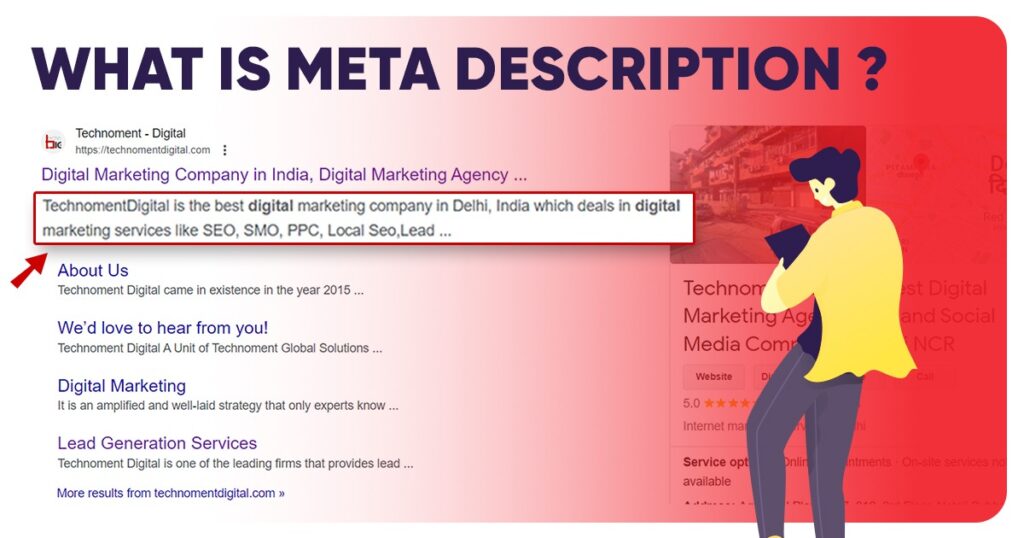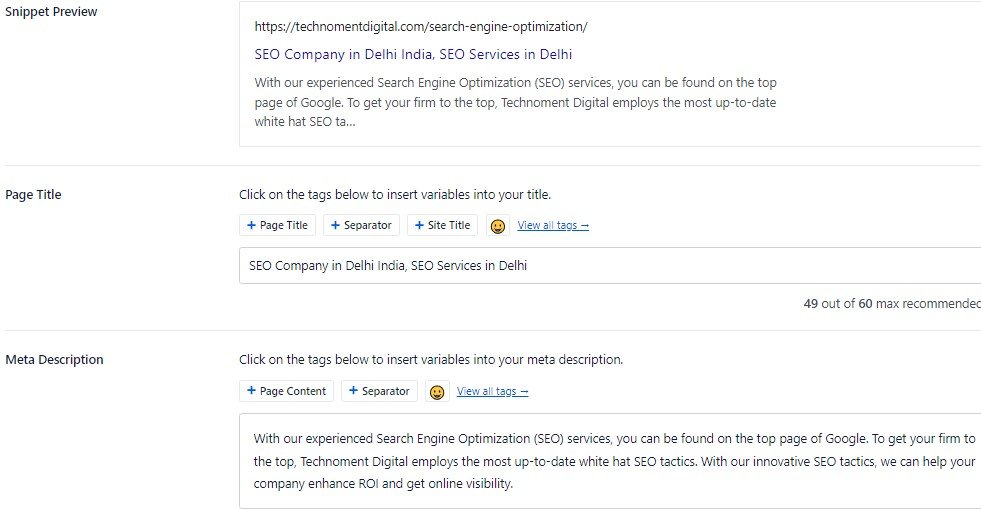
Have you ever wondered how search engines like Google provide a quick glimpse of a webpage’s content before you click on it? That’s where meta descriptions come into play. A meta description is like a summary of a webpage’s content, crafted in HTML format. When you search for something on Google, you’ll often see these meta descriptions displayed right beneath the webpage’s URL and title. They serve as a sneak peek, helping you decide whether the page is worth exploring. In this article, we’ll uncover the importance of meta descriptions and share effective strategies to create captivating ones that boost your website’s visibility and attract more organic traffic.
For example:

When it comes to managing your website’s content, most content management systems (CMSs) and SEO plugins provide an easy way to add and edit meta descriptions. You can simply type them into a specific field, and these meta descriptions are what search engines often display beneath your webpage’s title and URL in search results.
But that’s not all! Short descriptions from your meta tags can also show up as link previews on social media and other platforms. Sometimes, if you haven’t provided an Open Graph tag called “og:description,” these platforms might use your HTML meta description instead. So, it’s crucial to ensure you have engaging and well-crafted meta descriptions to make the best impression wherever your content appears.
For the ease of understanding, let’s take a look at an example from WordPress:

Why Do Meta Descriptions Matter in SEO?
Meta descriptions, also known as SEO meta descriptions, may not directly impact your website’s rankings according to Google’s algorithms. However, they still hold significant importance in the realm of SEO.
Why?
Because meta descriptions play a crucial role in generating snippets that provide a glimpse of your webpage’s content to search engine users. These snippets help your page stand out from competitors on the search engine results page (SERP).
A compelling snippet has the power to convince more people to click on your link, resulting in an improved click-through rate (CTR) for your website. Furthermore, an effective meta description can also contribute to increased brand awareness.
While meta descriptions may not be a direct ranking factor, their ability to entice users and improve your website’s visibility can have a positive impact on your overall SEO efforts.
Sometimes, Google takes into consideration the searcher’s intent when displaying snippets for your webpage. If Google believes that your HTML meta description doesn’t fully satisfy what the searcher is looking for, it may decide to generate a different snippet on the search engine results page (SERP). This means that the snippet displayed to users may not be the exact meta description you provided. Google aims to provide the most relevant and informative snippets to match the user’s query and improve their search experience. Therefore, it’s important to ensure that your meta description aligns well with the content of your webpage to increase the chances of Google using it as the displayed snippet.
To make it easier for users to find webpages that align with their needs, Google employs a helpful technique. When displaying search results, Google may highlight or bold keywords from the user’s query or other highly relevant text within the snippets. This feature allows users to quickly scan through the results and identify pages that are most likely to provide the information they’re seeking. By emphasizing these keywords, Google enhances the search experience, making it more efficient and convenient for users to discover relevant webpages.
It is evident that maintaining control over the snippets displayed for your website holds significant importance. This control allows you to safeguard your branding and ensure a consistent representation of your content across search engine result pages. To have this control in place, it becomes essential to focus on writing effective meta descriptions.
Here are some of the important tips for writing Meta Descriptions:
1. Consider the Length of Your Meta Description
When it comes to your meta description length, it’s crucial to strike the right balance. While there is no specific limit for HTML meta descriptions, Google truncates snippets based on available space, potentially impacting your click-through rate (CTR). Research by Semrush indicates that a shorter length of 105 characters is safer and can lead to a higher CTR. Keep in mind that the exact character count displayed in a snippet depends on factors like,
- the user’s search query
- device and
- character width
To ensure important information is not cut off, prioritize placing it at the front of your meta description to grab readers’ attention.
2. Incorporate the Main Keyword
Including the primary keyword in your meta description is essential – it’s the main search query you want your page to rank for. While it doesn’t have a direct impact on SEO, it can have an indirect influence on click-through rates (CTR). Google often highlights words from the search query or synonyms, making your meta description more noticeable. By incorporating the keyword, your SEO meta description stands out with bolded text, explicitly addressing the searcher’s needs and potentially increasing the likelihood of clicks.
3. Writing Meta Descriptions with User Intent in Mind
Crafting an impactful meta description involves grasping the searcher’s intent, understanding what they aim to achieve. Instead of providing a generic summary, 犀利士 focus on offering specific details that cater to their needs. Before writing your meta descriptions, conduct thorough search intent analysis to gain insights into what searchers are looking for. Once you have this understanding, you can confidently assure searchers that your page provides the precise information or solution they require, increasing the chances of attracting their attention and clicks.
4. Including Calls to Action (CTAs)
Incorporating calls to action (CTAs) within your meta descriptions can effectively prompt searchers to take action. Start your CTAs with action words to create imperative sentences that encourage readers to engage further.
By using CTAs you can make your meta descriptions more concise, engaging, and persuasive. Examples of CTAs:
- Buy Now
- Register Online
- Subscribe
- Sign Up
These CTAs provide clear direction and entice users to click, enhancing the overall effectiveness of your meta descriptions.
5. Testing and Optimization:
Search Engine Optimization is an ongoing process, and the same applies to meta descriptions. Regularly monitor the performance of your meta descriptions by analyzing CTRs and adjusting your approach accordingly. Split testing different variations of meta descriptions can provide valuable insights into what resonates best with your audience and drives higher click-through rates.
Conclusion:
In the ever-evolving world of SEO, meta descriptions continue to be an essential element in driving organic traffic to your website. Crafting compelling and relevant meta descriptions can significantly impact your search engine rankings, improve click-through rates, and ultimately boost your online visibility. By understanding the importance of meta descriptions and implementing the strategies outlined in this article, you can optimize your website’s performance and achieve greater success.
Remember, an effective meta description is like a window into your website, enticing users to take the next step and explore what your web page has to offer. Take the time to create captivating meta descriptions that accurately represent your content and watch as your organic traffic soars to new heights.

